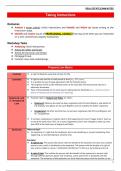Summary
Summary LPC Notes - Real Estate
- Course
- Institution
LPC Notes - Real Estate Distinction level notes for Real Estate The University of Law specific (2023) WS1 to WS15 Disclaimer - may contain typos, user is advised to make appropriate and suitable updates. Not for resale and/or distribution.
[Show more]



